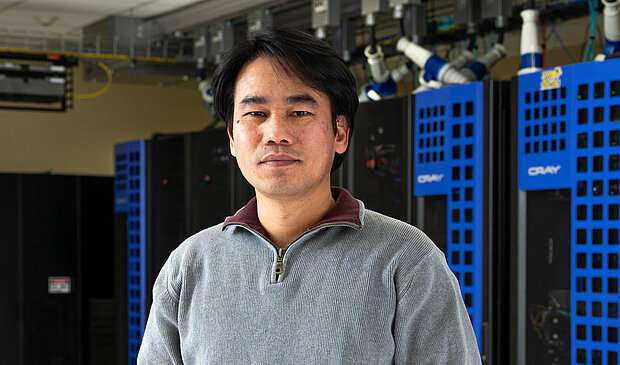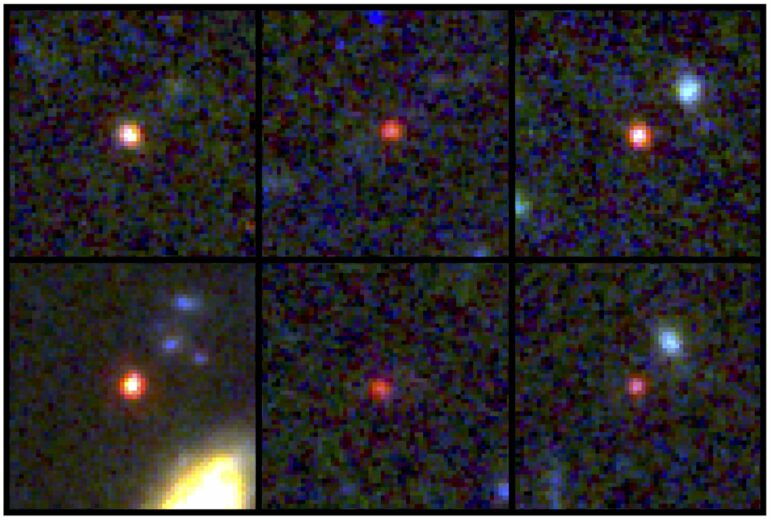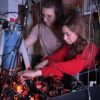A researcher in NDSU’s Center for Computationally Assisted Science and Technology and the Department of Physics has uncovered what makes a prominent paint glow in the dark for hours. The findings are reported in a paper titled “Defects and persistent luminescence in Eu-doped SrAl2O4,” published in the journal Physical Review Applied.
“The story really began on March 12, 1993, when researchers with Nemoto and Co. Ltd. in Japan successfully developed a new material that re-emits extremely bright green light over many hours in the dark,” said Khang Hoang, the author of the paper. “Their discovery gave birth to an exciting and rapidly growing era of scientific research on persistent luminescence—a physical phenomenon in which a material re-emits light over a long period of time after the light source has been switched off.”
The material is strontium aluminate with small amounts of rare-earth elements europium and dysprosium, which act as defects (atomic-scale imperfections) in the otherwise perfect crystal. The phosphor has been used as pigments in luminous paints and coatings for various applications. It is the material that makes the hands, dials and markers of a watch glow in the dark and is marketed under the brand names LumiNova, Super-LumiNova and LumiBrite, among others.
Over the past 30 years, the material has been studied intensively by many other researchers. Yet, details of the science behind its afterglow remained a mystery. New persistent phosphors also have been discovered, but the material invented by Nemoto is still the best phosphor commercially available.
“It is known that europium in strontium aluminate is responsible for the emitted green light,” Hoang explained. “Upon absorbing photons (light), electrons in the rare-earth ion are excited from one energy level to another, higher-energy level. The excited electrons can then recombine with holes (absence of electrons) that have been left behind and emit photons with energies in the green spectrum.”
To have delayed emission of light, other types of defects in addition to europium must be present. With suitable energy levels, these defects trap the excited electrons before they can recombine with holes and only release them gradually under thermal stimulation. The trapping and release can occur many times, as do the overall light absorbing and re-emitting processes. “Persistent phosphors are thus rechargeable optical batteries similar to lithium-ion electrochemical batteries in your phone or laptop that store energy for later use,” Hoang said.
Based on complex quantum mechanical calculations, Hoang identifies specific defects that are responsible for the persistent luminescence observed in the material. It turns out that extra strontium ions occupying the “wrong” sites in the atomic structure can trap and release electrons. Intentionally introduced dysprosium defects are much better electron traps, however, which lead to the bright and long-lasting light emission. The computational approach and the insight developed in the study will facilitate the design of new or improved persistent phosphors for practical applications.

Khang Hoang, researcher in NDSU’s Center for Computationally Assisted Science and Technology and the Department of Physics, has written a research paper for the Physical Review Applied of the American Physical Society. © North Dakota State University
Hoang credits the success of his project in a large part to the computing facilities available at NDSU. The recent addition and subsequent upgrade of a new supercomputing cluster have significantly improved the University’s research capabilities. Major support for the cluster came from the National Science Foundation through a Major Research Instrumentation grant in which Hoang was one of the principal investigators, and from America Rescue Plan Act funds. “My research and the research of many others would not be possible without such cutting-edge facilities,” Hoang said.
Hoang is a physicist whose research interests are at the intersections of physics, chemistry and materials science. He is included on Stanford University’s list of top scientists and was ranked among the world’s top 100,000 scientists for research impact in 2020. His current efforts involve designing materials for quantum information, photonics, optoelectronics and energy applications.
As a research facilitator at CCAST, Hoang advises other researchers on the application of supercomputing in various research fields and provides education and training in advanced research computing. Through CCAST’s training and internship programs, each year he trains more than 200 students, staff and faculty at NDSU and at other institutions in North Dakota and in the local Fargo-Moorhead area.
More information:
Khang Hoang, Defects and Persistent Luminescence in Eu -Doped SrAl2O4, Physical Review Applied (2023). DOI: 10.1103/PhysRevApplied.19.024060
Provided by
North Dakota State University
Citation:
Secrets of prominent luminous paint uncovered on 30th anniversary of its discovery (2023, March 2)



